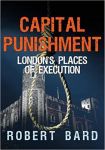Capital Punishment: London's Places of Execution by Robert Bard
| Capital Punishment: London's Places of Execution by Robert Bard | |
|
| |
| Category: History | |
| Reviewer: John Van der Kiste | |
| Summary: A concise look at various scenes of execution, and at the victims from all walks of life who were put to death there. Although it does not go into great detail, it servers as a useful and well-illustrated guide to the places and people involved. | |
| Buy? Yes | Borrow? Yes |
| Pages: 96 | Date: November 2016 |
| Publisher: Amberley Publishing | |
| ISBN: {{{isbn}}} | |
|
| |
The majority of books on true crime and murder focus first and foremost on specific incidents. This concise volume takes a different approach, in dealing with them according to where the executioner completed his task.
An introduction discusses murder and execution as a social phenomenon – for want of a better term – in that the application of the death sentence was for a long time a public spectacle. King Charles I was beheaded in full view of a crowd made up of royalists and republicans, while the escorting of ordinary murderers to the scaffold likewise provided entertainment - the Victorian equivalent of a reality show, at the risk of sailing a little close to the boundaries of good taste - until the Capital Punishment (Amendment) Act, passed in 1868, confined executions to prisons away from the public gaze. During the Stuart era, Samuel Pepys would write in his diary of having gone to watch an offender being put to death as if he had just been to a day at the races. But two centuries later, figures such as Lord Palmerston and Charles Dickens were openly supporting the abolition of the death penalty.
Next comes an overview of the grim realities of execution and London society. The eighteenth century was not a good time for the criminal, for between the 1680s and the 1720s the number of offences punishable by death rose from around 80 to over 350. Nevertheless it was meant to serve as a warning at least; many sentences were commuted to transportation to the colonies, or pardons for the most fortunate. Royalty and aristocracy – be you ever so mighty, you were not above the law – had the privilege of meeting death at the hands of the headsman, though it was anything but a privilege for the unlucky ones such as Margaret de la Pole, ill-fated daughter of George, Duke of Clarence, who had a singularly clumsy axeman who needed several blows to complete his grisly work. Others might be hung, drawn and quartered, burnt at the stake, or left to suffocate on a noose which failed to perform its function with sufficiently merciful speed.
The main body of the book looks at particular locations, with an account of the deaths of the most famous people to die there. First is the best-known of all, Tyburn, where people were executed from the early twelfth century to 1783. A plaque on a traffic island between Bayswater Road and Edgware Road now marks the approximate location of where the gallows once stood. Newgate Gaol, Charing Cross, Lincoln's Inn Fields, Smithfield, and Old and New Palace Yards, Westminster, also witnessed similar ceremonies. Each short chapter includes accounts of deaths by every form of execution, from hanging and beheading to burning at the stake, for those convicted of murder, treason and other capital offences, in some cases even stealing.
Tower Green and Tower Hill marked the demise of the most famous victims. Among them were two of Henry VIII's wives, Anne Boleyn and Catherine Howard, as well as Lady Jane Grey and the Earl of Essex, once the favourite of Elizabeth I and later leader of an abortive rebellion against her. Another was James, Duke of Monmouth, illegitimate son of Charles II and leader of an uprising against his unforgiving uncle James II. The executioner chosen to despatch him had such a fit of the nerves that at one stage he offered forty guineas to any member of the crowd who could finish the job that he had started so badly.
Although this is a brief book, it provides a useful look at its subject. There are illustrations and photographs on almost every page, including contemporary engravings and the present-day locations, alongside portraits of the more illustrious victims of executioners over the ages.
For a more detailed account of specific murders from medieval days to the twentieth century, we also recommend Capital Crimes: Seven centuries of London life and murder by Max Decharne, and for shorter coverage of many more from the last two hundred years, Murders of London: In the steps of the capital's killers by David Long.
Please share on: ![]() Facebook,
Facebook, ![]() Twitter and
Twitter and
![]() Instagram
Instagram
![]() You can read more book reviews or buy Capital Punishment: London's Places of Execution by Robert Bard at Amazon.co.uk Amazon currently charges £2.99 for standard delivery for orders under £20, over which delivery is free. (Paid link)
You can read more book reviews or buy Capital Punishment: London's Places of Execution by Robert Bard at Amazon.co.uk Amazon currently charges £2.99 for standard delivery for orders under £20, over which delivery is free. (Paid link)
![]() You can read more book reviews or buy Capital Punishment: London's Places of Execution by Robert Bard at Amazon.com. (Paid link)
You can read more book reviews or buy Capital Punishment: London's Places of Execution by Robert Bard at Amazon.com. (Paid link)
Comments
Like to comment on this review?
Just send us an email and we'll put the best up on the site.


